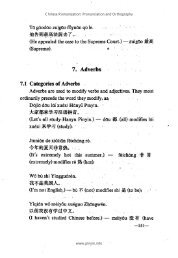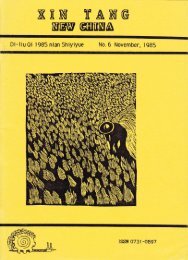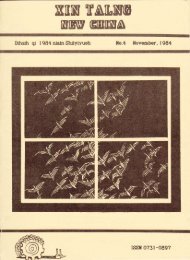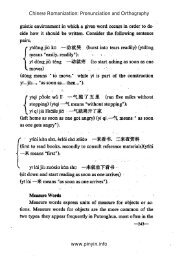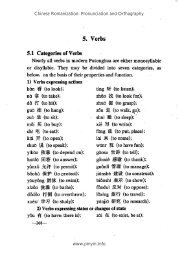XIN TANG (New China) - Pinyin.info
XIN TANG (New China) - Pinyin.info
XIN TANG (New China) - Pinyin.info
- No tags were found...
Create successful ePaper yourself
Turn your PDF publications into a flip-book with our unique Google optimized e-Paper software.
23 <strong>XIN</strong> <strong>TANG</strong>: NEW CIUNAextensive uses of simple phonetic writing, the traditionalkJmji-plus-kIDll script remains dominant and shows noevidence of losing its favored position.Korea has experienced a linguistic cleavage thatparallels the political division of the country. The NorthKoreans seized the opportunity presented by the ouster ofthe Japanese and abandoned characters completely in 1949in favor of the indigenous hangul alphabet that was createdin the 15th century. The South Koreans have vacillated intheir language policy. at times stressing characters, attimes stressing hangul. As a result, the genenl level ofmastery of chancters has declined. Although unofficiallyalphabetic writing is playing a greater and greater role,the chancter-plus-hangYi script continues in favor inofficial and academic circles.Viet Ham thus remains the sole example of asuccessful complete transition from character-basedwriting to alphabetic writing. Its struggles to effect thischange throw an instructive light on IIIIIny aspects of thecomplex problem of writing reform in the areas wherechancters are still dominant.*This article is based mainly on the author'sColgnjalism gnd 19n9uage pglicy in Yjet Ham (The Hague:Mouton, 1977) and -Vietnamese Writing Reform in AsianPerspective,- a paper presented at a symposium at theUniversity of Hawaii in July, 1983, on Borrowings andAdaptations in Vietnamese Culture and published insoutheast Asia Papers #25 (Honolulu: University of HawaiiPress, 19851.



